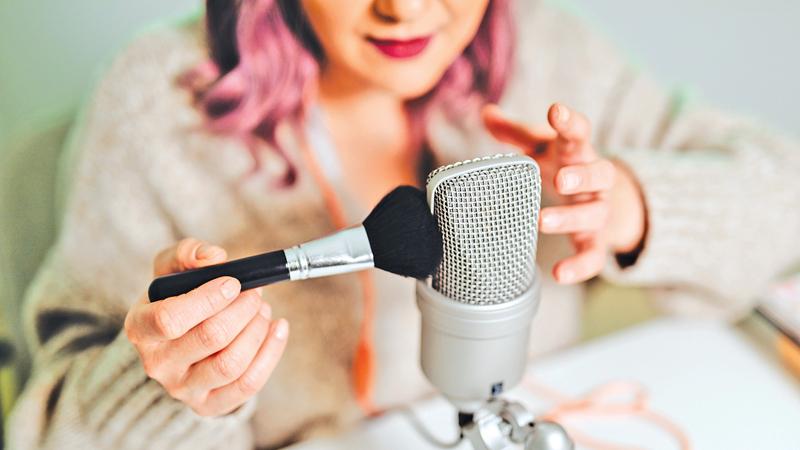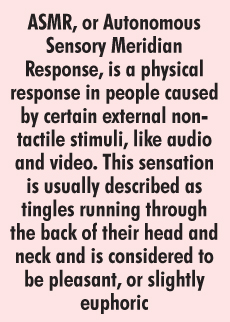

ASMR, or Autonomous Sensory Meridian Response, is a physical response in people caused by certain external non-tactile stimuli, like audio and video. This sensation is usually described as tingles running through the back of their head and neck and is considered to be pleasant, or slightly euphoric. While this odd physical phenomenon can be used as an effective sleeping aid, or a quick dose of dopamine for some niche groups of people, in recent times, ASMR has become a low-key viral trend online. This new, relatively unknown movement of ASMR has inspired a multitude of content on streaming platforms like YouTube and Twitch.
Identification of ASMR
The identification of ASMR as a concept is quite a recent thing, but the idea of it existed before this. The oldest known record of anything that sounded similar to the idea of ASMR is a passage in Virginia Woolf’s 1925 novel, Mrs Dalloway, which explicitly describes the spine and head sensation as a result of an auditory stimulus. However, the modern idea of ASMR was identified entirely online, through certain online communities who recognised this physical reaction. In 2007, in a medical website called Steady Health, this phenomenon was dubbed AIHO, or Attention Induced Head Orgasm, after the euphoric physical sensation experienced through receiving tender personal attention like ear cleaning or hair cutting, another cause of ASMR. A now defunct web forum would also be set up for AIHO but the idea would remain niche until 2010, when a facebook group for those experiencing that sensation coined the term ASMR.
 From the inception of that facebook group, called Autonomous Sensory Meridian Response, in 2010, the popularity of the concept of ASMR would skyrocket. Though the group would continue to try gaining legitimacy for the term, even setting up a site for the purposes of supporting scientific studies relating to ASMR, it would be a while before ASMR received any scientific backing. In the meantime, the internet news message board Reddit picked up the concept and gave it its first taste of mainstream popularity. ASMR even got its own subreddit, r/asmr, which today has over 200,000 members. This attention eventually got the attention of the Huffington Post in 2012, and not a month later, a legitimate neuroscience blog, Neurologica, made a post on ASMR, even noting the internet’s role in its discovery.
From the inception of that facebook group, called Autonomous Sensory Meridian Response, in 2010, the popularity of the concept of ASMR would skyrocket. Though the group would continue to try gaining legitimacy for the term, even setting up a site for the purposes of supporting scientific studies relating to ASMR, it would be a while before ASMR received any scientific backing. In the meantime, the internet news message board Reddit picked up the concept and gave it its first taste of mainstream popularity. ASMR even got its own subreddit, r/asmr, which today has over 200,000 members. This attention eventually got the attention of the Huffington Post in 2012, and not a month later, a legitimate neuroscience blog, Neurologica, made a post on ASMR, even noting the internet’s role in its discovery.
Researcha
However, even though there has been recognition from the scientific community, with many research studies being published on it, it’s been inherently difficult to research as it is a phenomenon that you can’t see or feel and doesn’t occur in everyone. So far, the consensus seems to be that ASMR is most likely something real, but the exact science behind it is not concrete as of yet. Despite this, studies have managed to recognize all the known triggers associated with ASMR. While most people assume ASMR content only consists of whisper videos, that is just one type. While it may be the most common trigger, associated with 75 percent of people, ASMR content also consists of other auditory stimuli such as two objects rubbing together, personal attention role play, clinical or medical role play. In addition to audio visual stimuli, tactile contact can also cause ASMR, such as light touches on the skin.
Today, ASMR content is incredibly well received, with over 15 million videos on YouTube alone as of 2021. Beyond YouTube, ASMR has also been accepted into other media such as contemporary art, music, film and TV. ASMR has become a truly global phenomenon, especially popular in Japan where it has mainstream appeal. What started as a small forum in one corner of the internet has turned into a massive community of people coming together through shared experience of ASMR.
